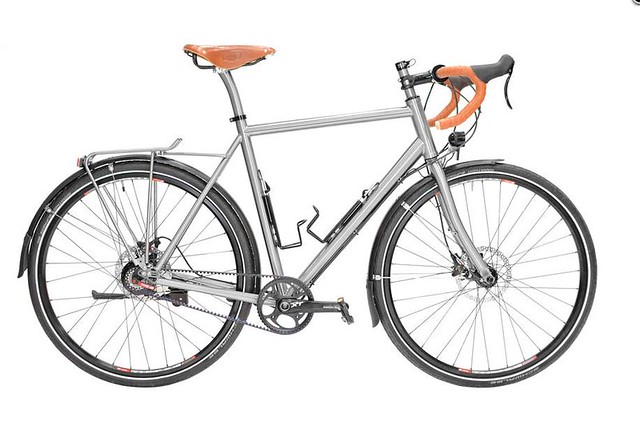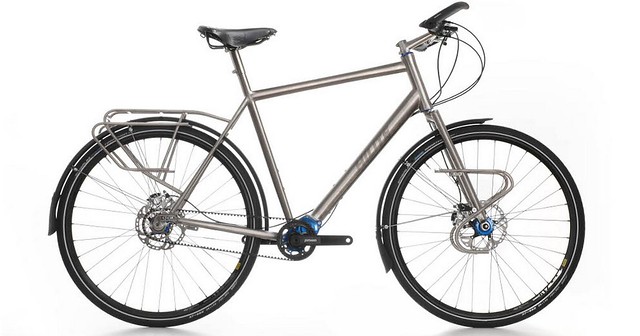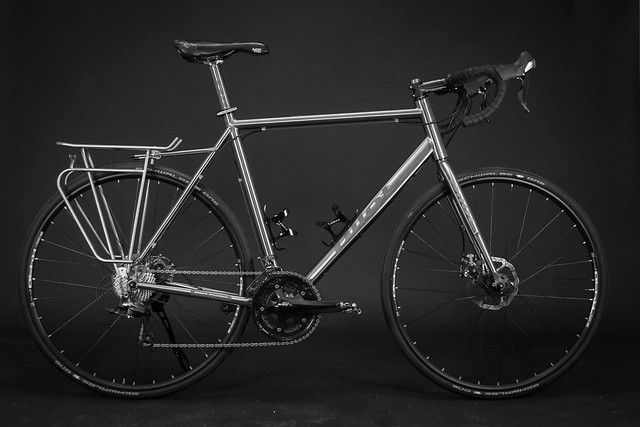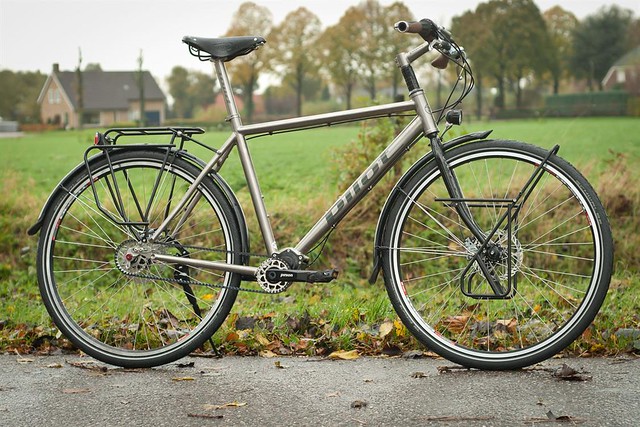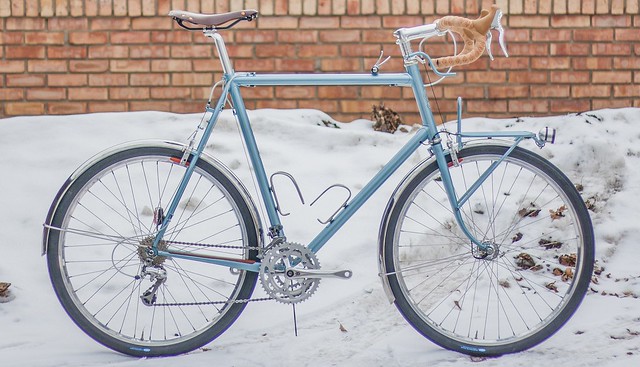ABOUTCYLING have this great list on their site
I’ve completed an internet trawl to find some of the nicest, most aesthetically pleasing touring bikes getting about and I don’t think you’ll be disappointed with what’s coming up.
Somehow I’ve ended up with the majority of these bikes made in the USA, so either my taste is for North American builders, or perhaps North American builders are better exposed on the internet. I’m keen to get a more international splash of handmade bikes on this page, so please drop a comment with a bike that you think is just as worthy as these. It has to be pretty special, with nice paint and colour-matched parts – good driveside pictures are also essential.
Stats
Out of the 28 bikes on showcase, this is the characteristic breakdown:
- Handlebars: Drop (20), Flat (8).
- Brakes: Disc (14), Cantilever (10), Road (1), hydraulic rim (1), V-brake (2).
- Mudguards: Metal (15), Plastic (6), None (6), Wooden (1).
- Frame Material: Titanium (14), Steel (10), Stainless Steel (4).
- Gears: Derailleur (17), Internally Geared Hub (9), Gearbox (2).
- Shifters: STI (7), Barend (5), Gripshift (10), Downtube (2), Trigger (2), Stem (1), Retroshift (1).
- Country of Origin: USA (19), Australia (3), Switzerland (3), The Netherlands (3).
Hilite
This Swiss company works with titanium to make unique touring bikes for purposes from light touring to expedition. We couldn’t pick one to show you, so we settled for three. Many of their bikes use Rohloff 14s hubs, Pinion 18s gearboxes and Gates Carbon Drive. Integrated racks and seatposts, and matching stems finish the Hilite look.
Van Nicholas
This Dutch builder has specialised in titanium over the years, putting together some mighty fine looking touring bikes. The Pioneer Rohloff 29er is unique compared to most touring bikes, in that it can squeeze in wide 700c tyres. Van Nicholas come with all the top end touring gear, including Gates Carbon Drive and Rohloff 14s hubs. Matching stems, handlebars and seatposts complete the look.
Breadwinner
Breadwinner of Portland (USA) are Ira Ryan and Tony Pereira. These two builders teamed up together “to get more beautiful bikes to more people who ride everyday”. Although I’m not a huge fan of the green, the matching stem and pump look superb, and make sure to check out the headtube badge in Breadwinner’s website – it’s a work of art. The only thing I don’t agree at all with is the use of Shimano Ultegra crankset and derailleurs, as they’re too modern-looking on such a classic bike. If it were mine, it’d be silver Campagnolo components instead.
Ti Cycles
Dave Levy of Ti Cycles has gone all out on this unique ride. In Dave’s Portland (USA) workshop, he has managed to create a titanium frame that looks nothing like the rest on the list, given the hyper extended top tube. The more impressive features include the custom ti racks with integrated mudguard struts, the u-lock holder and the Supernova dynamo light fittings. My only gripes are the use of yellow on the stem and the Shimano road crankset which seems a bit out of place here.
Horse Cycles
Light blue is pretty much my favourite colour, so it is no suprise that this stainless steel Horse by Thomas Callahan in New York (USA) makes the list. It seems a bit more randonneur than most on this list, but given it has custom front and rear racks we’ll consider it a tourer. The colour-matched ‘guards look incredible, as do the racks and fillet-brazed stem. My only gripe is that the crankset does not fit in… at all. A White Industries crankset in silver would make me much happier.
Ahearne
This stainless steel, fillet-brazed beauty is possibly the wackiest ride on this list, and is without doubt the most expensive. Somewhere between a work of art and a very capable tourer, it was built by Joseph Ahearne in Portland, taking six weeks to build, at 10-12 hours a day with no days off. The estimated value is $25,000 USD, which is presumedly made up in labour costs. Interesting features include the high polish finish which exposes immaculate fillet brazing, KVA stainless steel tubing which is much thicker than any other option, Ritchey breakaway parts, additional support tubing for the seatstay/toptube, custom steel racks with a built-in lock holder, a flask holder on the downtube, a super retro Shimano derailleur and a logo panel made of stainless which has been laser cut and left unpolished on the downtube. This Ahearne Flickr album is a must see to understand the level of detail and work that went into this amazing ride!
Chapman Cycles
This touring bike features stainless steel lugs, fenders and fork crown, which looks beautiful against the stealth finish. The fork has a built in dynamo connector, allowing the dynamo wire to run on the inside of the fork leg for a neat look. This wire powers both the lights and the USB plug found on the top of the stem. The Tubus rear rack has been stripped of it’s original paint, and chrome plated, matching the front rack perfectly. Even the saddle has a custom finish on it, the leather replaced and re-stitched to match the yellow cables. More photos on the Chapman website.
Firefly
It’s my opinion that Firefly Bicycles of Boston (USA) make some of the nicest titanium and stainless steel bikes in the world. The upper bike is setup with Shimano electronic gearing which is normally only featured on road bikes, but has been fitted to work with MTB parts in this case. The lower two bikes have splits for Gates Carbon Drive which works seamlessly in combination with the Rohloff 14s hub – we certainly love our drivetrain. The Firefly lettering is sometimes buffed up to a glossy finish on the downtube and can be chemically coated with anything from gold to a rainbow effect. Other nice features include built-in rear racks, internal cabling, custom dynamo light mounts and stunning titanium stem and seatpost combos. James Medeiros and Tyler Evans of Firefly have nailed these modern touring bikes. More @ Firefly’s Flickr.
A-Train
Alex Cook of A-Train Bicycles in Minneapolis (USA) has whipped together an incredibly simple and elegant tourer. The material of choice: stainless steel. This frame uses stainless S&S couplers which bring the packed bike size right down to about half the regular length. The A-train custom racks blend right in to this bike.
Bilenky
I was trying to pick one titanium Bilenky tandem, but just couldn’t do it. These two titanium bikes are probably the nicest touring tandems I’ve ever laid my eyes on. The top tandem, which a bit more of a randonneur, has enough purple to be crazy, but somehow still pulls off a very elegant look (in my humble opinion). The below tandem is long-distance touring ready with a Rohloff hub and some schmick looking racks. The frame is without doubt the most impressive part however, as the curvy, retro style is still very functional and even breaks into three parts so that you can easily get it into an plane. These incredible tandems are manufacturered by Stephen Bilenky and family in Philadelphia (USA).
Independent Fabrication
Indy Fab of Newmarket (USA) have been around longer than most, and as a result, have mastered the frame-building trade. The finish on an Indy Fab is generally 10/10 and these look to be no exception. I also have no doubts that both would be sturdy enough to complete round-the-world trips. Here’s hoping they get ridden regularly! Via Indy Fab.
Hufnagel
Jordan Hufnagel has put together this georgeous classic tourer in bespoke bike central, Portland (USA). The paint-matched stem and racks are pure class and I especially love the wooden panels that are inserted into the racks. More images @ UrbanVelo.
Pereira
Tony Pereira, based in Portland (USA), has built this 650b bike up nice and classic. The high top tube, downtube shifters and birch finish give this bike a timeless look. A colour-matched stem, pump and Tubus cargo rack finish the build very well. I can’t help but think the bike would look much better with some brown leather Brooks bartape to match the saddle.
Baum
Darren Baum of Geelong (Australia) is a household name around custom bike enthusiasts. His frames are world class and are always dressed with incredible paint jobs. These two bikes have been put together for two cyclists who completed a charity ride across three continents, documented on the website The Long Road Tour. Check out the Baum Flickr for more.
Pilot
Pilot make their titanium bikes in the Netherlands; the finishing is top quality! On these bikes you’ll find Rohloff 14s hubs, Pinion 18s gearboxes and Gates Carbon Drivetrains. They’re certainly something to drool over.
Clockwork
This custom Clockwork randonneur was too good to keep off the list! Apart from the stunning looks, there are lots of nice design details to be found including a custom mount for downtube shifters located on the top tube. The matching painted rack and leather saddle complete the look.
Kumo
Keith Marshall from Canberra (Australia) is inspired by Japanese metalwork, but really, the Japanese should probably be inspired by him! This stainless steel beauty is again a bit more on the randonneur side of things, but damn, look at it! It features S&S couplers to break the frame down nice and small, internal cable routing for the dynamo lights and beautiful Llewellyn lugs (these lugs are best in the business btw). More @ Kumo Cycles.
Geekhouse
John from the Radavist takes photos of the nicest custom bikes in the world, but also has his fair share of sweet rides! I love the simplicity and colour of his Geekhouse, which is made by Marty Walsh and the team in Boston (USA). John has the colours and tones on this bike right down to the gold bidons – I love the custom racks too! The bike employs a double 50-32 crankset and an 11-36t cassette which gives ample low-end gearing for the type of riding John does. More @ The Radavist.
Vanilla Bikes
Sacha White of Vanilla Bicycles in Portland (USA) had so many pre-ordered frames to build that he no longer takes orders! That’s 5+ years worth, so I hope you’re not lusting for one too badly. This Vanilla is more of a randonneur than a tourer, but given it’s impeccable finish it was too hard to keep it off my list. I particularly love the lugs and the colour matched guards/pump. The stem is a work of art too, check it out on the Vanilla website.
Rivendell
Rivendell are very well known for their touring bikes but this Hunqapillar takes the cake. The diagatube is the most obvious feature on this bike, designed to stiffen the bike up by increasing the triangulation. Wooden guards, a lugged frame construction, retro racks and the Rohloff 14s hub give this bike a distinctive look.
Building a Beautiful Touring Bike
Follow these tips and you can have your very own gorgeous tourer. Remember, it doesn’t have to be custom-made to look incredible!
1. Keep your colours to a minimum. Two colours are enough (not including your black and silver components), three starts to look messy but can be pulled off.
2. Balance your silvers and blacks. Bikes typically look better with a mix of black and silver components. It’s hard to completely avoid black as it’s often found at the lever hood or on the tyres at a minimum. I really like it when silver hubs, silver mudguards and a silver crankset are used with all black components.
3. Match the colour of your seat and bartape/grips. This is the easiest way to make any bike look extra nice.
4. Use metal mudguards. Polished or hammered metal guards are all class. Who cares if they weigh more?
5. Paint your mudguards the same colour as your frame. Colour-matched guards are all class.
6. Paint your stem and racks the same colour as your frame. You’ll notice a number of the bikes featured in this article feature colour matched parts.
7. Use classic-styled cranks on classic-styled builds. There is nothing worse than a modern road crankset on a classic build (see the Horse above). White Industries, Middleburn and Campagnolo make some nice classic cranks.
